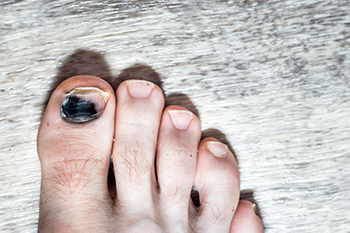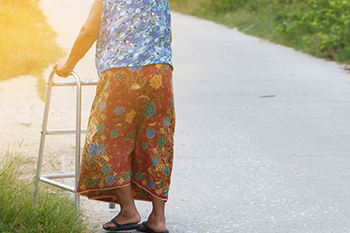Langley (604)-530-1561
Fax (778)-278-1561
Email podiatry@urton.ca
July 2023
Pronation in Children

Pronation in children can indicate delays in standing, walking, and running. It refers to the inward roll of a child's ankle, often associated with terms like flat feet, flexible flat foot, pes planus, or overpronation. This issue originates from the heel, where the bone rotates inward, leading to weight shifting and walking on the inner part of the foot. Children with low muscle tone or ligament laxity are more susceptible. Excessive relaxation of ligaments can cause the ankles to roll in, disrupting alignment in the knees, hips, and back, potentially resulting in pain. If your child exhibits pronounced pronation, causing problems such as pain, fatigue, or clumsiness, it is suggested to consult a podiatrist for an examination and appropriate treatment.
Flatfoot is a condition many people suffer from. If you have flat feet, contact William Urton, DPM from British Columbia. Our doctor will treat your foot and ankle needs.
What Are Flat Feet?
Flatfoot is a condition in which the arch of the foot is depressed and the sole of the foot is almost completely in contact with the ground. About 20-30% of the population generally has flat feet because their arches never formed during growth.
Conditions & Problems:
Having flat feet makes it difficult to run or walk because of the stress placed on the ankles.
Alignment – The general alignment of your legs can be disrupted, because the ankles move inward which can cause major discomfort.
Knees – If you have complications with your knees, flat feet can be a contributor to arthritis in that area.
Symptoms
- Pain around the heel or arch area
- Trouble standing on the tip toe
- Swelling around the inside of the ankle
- Flat look to one or both feet
- Having your shoes feel uneven when worn
Treatment
If you are experiencing pain and stress on the foot you may weaken the posterior tibial tendon, which runs around the inside of the ankle.
If you have any questions please feel free to contact our office located in Langley, BC . We offer the newest diagnostic and treatment technologies for all your foot and ankle needs.
Toenail Issues Common to Runners

Distance runners often experience problems with their toenails, and the three main types are thick nails, bruised nails, and toenail loss. While in many cases the appearance of thick toenails can indicate a fungal infection, in runners they can also be a result of pressure from their shoes and socks, or wearing shoes that don’t fit properly. A toenail that looks blue or black is likely to be caused by a bruise underneath it. The change in color is caused by blood forming under the nail, often from direct trauma to the toe. In some cases, the blood will need to be drained in a medical procedure conducted by a podiatrist. Many runners are surprised when one of their toenails falls off. In most cases, a new nail will form. To avoid losing a toenail, experts recommend being sure that your running shoes fit well, keeping toenails properly trimmed, and making sure your shoes are completely dry before a run. If you notice a bruise, a thick nail, or a loose toenail, it is suggested that you consult a podiatrist sooner rather than later, before the matter worsens and prohibits you from running.
All runners should take extra precaution when trying to avoid injury. If you have any concerns about your feet, contact William Urton, DPM of British Columbia. Our doctor will treat your foot and ankle needs.
How to Prevent Running Injuries
There are a lot of mistakes a runner can make prior to a workout that can induce injury. A lot of athletes tend to overstretch before running, instead of saving those workouts for a post-run routine. Deep lunges and hand-to-toe hamstring pulls should be performed after a workout instead of during a warmup. Another common mistake is jumping into an intense routine before your body is physically prepared for it. You should try to ease your way into long-distance running instead of forcing yourself to rush into it.
More Tips for Preventing Injury
- Incorporate Strength Training into Workouts - This will help improve the body’s overall athleticism
- Improve and Maintain Your Flexibility – Stretching everyday will help improve overall performance
- “Warm Up” Before Running and “Cool Down” Afterward – A warm up of 5-10 minutes helps get rid of lactic acid in the muscles and prevents delayed muscle soreness
- Cross-Training is Crucial
- Wear Proper Running Shoes
- Have a Formal Gait Analysis – Poor biomechanics can easily cause injury
If you have any questions, please feel free to contact our office located in Langley, BC . We offer the newest diagnostic and treatment technologies for all your foot care needs.
Household Strategies That May Help to Prevent Falling

Research has shown that approximately 25 percent of Americans who are 65 years or older fall every year. Physical harm may happen as a result of falling, and the feet are often affected. A broken foot or toe are common injuries after a fall has occurred, which can limit the ability to complete daily activities. People who fall and are fortunate enough to not become hurt may develop a fear of falling. This can lead to becoming inactive and sedentary, which may be a gateway into other physical conditions. There are simple methods that can be implemented that can effectively prevent falling. These can include having routine physical and eye examinations that help update existing medications and eyeglasses. Additionally, it is beneficial to install grab bars in the toilet and shower area and to improve lighting in the household. If you require more knowledge about fall prevention strategies, it is suggested that you confer with a podiatrist who can provide you with useful tips on foot protection.
Preventing falls among the elderly is very important. If you are older and have fallen or fear that you are prone to falling, consult with William Urton, DPM from British Columbia. Our doctor will assess your condition and provide you with quality advice and care.
Every 11 seconds, an elderly American is being treated in an emergency room for a fall related injury. Falls are the leading cause of head and hip injuries for those 65 and older. Due to decreases in strength, balance, senses, and lack of awareness, elderly persons are very susceptible to falling. Thankfully, there are a number of things older persons can do to prevent falls.
How to Prevent Falls
Some effective methods that older persons can do to prevent falls include:
- Enrolling in strength and balance exercise program to increase balance and strength
- Periodically having your sight and hearing checked
- Discuss any medications you have with a doctor to see if it increases the risk of falling
- Clearing the house of falling hazards and installing devices like grab bars and railings
- Utilizing a walker or cane
- Wearing shoes that provide good support and cushioning
- Talking to family members about falling and increasing awareness
Falling can be a traumatic and embarrassing experience for elderly persons; this can make them less willing to leave the house, and less willing to talk to someone about their fears of falling. Doing such things, however, will increase the likelihood of tripping or losing one’s balance. Knowing the causes of falling and how to prevent them is the best way to mitigate the risk of serious injury.
If you have any questions, please feel free to contact our office located in Langley, BC . We offer the newest diagnostic and treatment technologies for all your foot care needs.
Why Live with Pain and Numbness in Your Feet?
An Achilles Tendon Tear

When the tendon that attaches the calf muscle to the heel is completely torn, it is known as an Achilles tendon tear. This injury is often seen in middle-aged male sports participants. The Achilles tendon is the largest tendon in the body, and it is prone to injury, especially during sports involving running and jumping because sudden and explosive force is exerted on it. Certain antibiotics and cortisone shots can make one more apt to tear this tendon, and some medical professionals do not give cortisone shots for Achilles tendonitis for this reason. The main symptom of an Achilles tear is sudden and intense pain behind the ankle. Some who have sustained this injury have heard a popping or cracking sound and describe it as being kicked in the heel. There is often difficulty pointing toes down and some may experience swelling and bruising around the tendon. If you think you have torn your Achilles tendon, it is strongly suggested that you see a podiatrist as soon as possible for a proper diagnosis and treatment.
Achilles tendon injuries need immediate attention to avoid future complications. If you have any concerns, contact William Urton, DPM of British Columbia. Our doctor can provide the care you need to keep you pain-free and on your feet.
What Is the Achilles Tendon?
The Achilles tendon is a tendon that connects the lower leg muscles and calf to the heel of the foot. It is the strongest tendon in the human body and is essential for making movement possible. Because this tendon is such an integral part of the body, any injuries to it can create immense difficulties and should immediately be presented to a doctor.
What Are the Symptoms of an Achilles Tendon Injury?
There are various types of injuries that can affect the Achilles tendon. The two most common injuries are Achilles tendinitis and ruptures of the tendon.
Achilles Tendinitis Symptoms
- Inflammation
- Dull to severe pain
- Increased blood flow to the tendon
- Thickening of the tendon
Rupture Symptoms
- Extreme pain and swelling in the foot
- Total immobility
Treatment and Prevention
Achilles tendon injuries are diagnosed by a thorough physical evaluation, which can include an MRI. Treatment involves rest, physical therapy, and in some cases, surgery. However, various preventative measures can be taken to avoid these injuries, such as:
- Thorough stretching of the tendon before and after exercise
- Strengthening exercises like calf raises, squats, leg curls, leg extensions, leg raises, lunges, and leg presses
If you have any questions please feel free to contact our office located in Langley, BC . We offer the newest diagnostic tools and technology to treat your foot and ankle needs.








